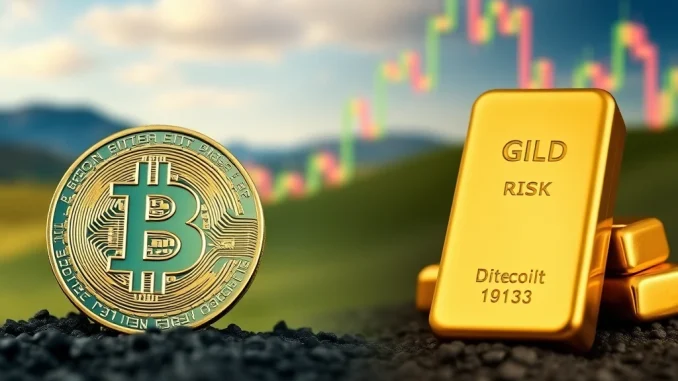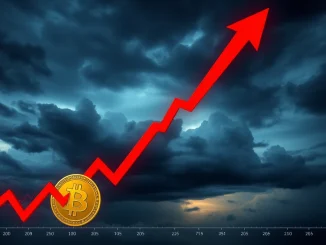
Are you an investor trying to make sense of the evolving financial landscape? Many traditional investors view gold as the ultimate safe haven, a reliable store of value against inflation and economic uncertainty. But what about Bitcoin? Often called ‘digital gold,’ the leading cryptocurrency has carved out its own place in the market. While seemingly different, recent analysis suggests these two assets might be showing a surprising similarity in their investment profiles, particularly concerning risk.
Understanding Risk-Adjusted Performance: What the Sharpe Ratio Tells Us
When we talk about investments, it’s not just about how much money you make, but how much risk you took to make it. This is where risk-adjusted performance comes into play. A key metric used by analysts to measure this is the Sharpe ratio.
The Sharpe ratio essentially tells you the return of an investment compared to its risk. A higher Sharpe ratio means you’re getting more return for each unit of risk you take on. It helps investors understand if an investment’s returns are due to smart decisions or just excessive risk-taking.
Is the Gap Narrowing? Bitcoin and Gold’s Sharpe Ratios
According to insights shared by Jurrien Timmer, Director of Global Macro at Fidelity Investments, the gap between the Sharpe ratios of Bitcoin and gold has been narrowing. Timmer highlighted this trend in a recent post on X (formerly Twitter).
For years, Bitcoin was known for its explosive returns but also its extreme volatility, often resulting in a lower Sharpe ratio compared to more stable assets like gold over certain periods. However, as the market matures and volatility potentially decreases relative to returns, Bitcoin’s risk-adjusted performance appears to be aligning more closely with that of gold.
Gold vs. Bitcoin: A Look at Recent Performance
While the Sharpe ratio focuses on risk-adjusted returns over time, it’s also useful to look at raw price performance. Data from Ecoinometrics provides a snapshot of how both assets have performed so far in 2025:
- Gold: Increased by 30.33%
- Bitcoin: Gained 3.84%
This data point shows that, at least year-to-date in 2025, gold has significantly outperformed Bitcoin in terms of percentage gain. This contrasts with the long-term trend where Bitcoin often saw much larger percentage increases. This short-term snapshot doesn’t negate the Sharpe ratio analysis, which considers volatility and performance over broader periods, but it serves as a reminder that market dynamics can shift.
Bitcoin and Gold as a Store of Value: Timmer’s Hedge Suggestion
Both Bitcoin and gold are often discussed in the context of being a store of value – assets expected to retain their purchasing power over the long term, especially during inflationary periods or economic instability. Timmer’s analysis supports this idea, suggesting a potential strategy for investors.
He proposed that a 4:1 ratio of gold to Bitcoin could serve as a sensible hedge within a portfolio focused on preserving value. This doesn’t mean replacing one with the other entirely, but potentially using both in a diversified approach, leveraging gold’s historical stability and Bitcoin’s digital potential.
What Does This Mean for Investors?
The increasing similarity in risk-adjusted performance between Bitcoin and gold has several implications:
- Diversification: It reinforces the idea that investors might consider allocating a portion of their portfolio to both assets, potentially benefiting from different market drivers while managing overall risk.
- Maturity of Bitcoin: The narrowing Sharpe ratio gap could signal Bitcoin’s growing maturity as an asset class, moving beyond purely speculative trading to being considered for its long-term value retention potential.
- Changing Perceptions: As analysis like Timmer’s becomes more widespread, traditional investors who previously dismissed Bitcoin might start viewing it through a more familiar risk/return lens, similar to how they evaluate gold.
Conclusion: Are Bitcoin and Gold Becoming Two Sides of the Same Coin?
While gold has a millennia-long history as a reliable store of value and Bitcoin is a relatively new, volatile digital asset, analysis from experts like Jurrien Timmer indicates a fascinating convergence in their risk-adjusted performance profiles, as measured by the Sharpe ratio. The recent short-term performance data shows gold leading the pack in 2025, but the long-term trend suggests Bitcoin’s investment characteristics are becoming more aligned with its physical counterpart. This evolving relationship encourages investors to look beyond surface-level differences and consider how both assets might play a role in a diversified portfolio aimed at preserving value in an uncertain economic future.



